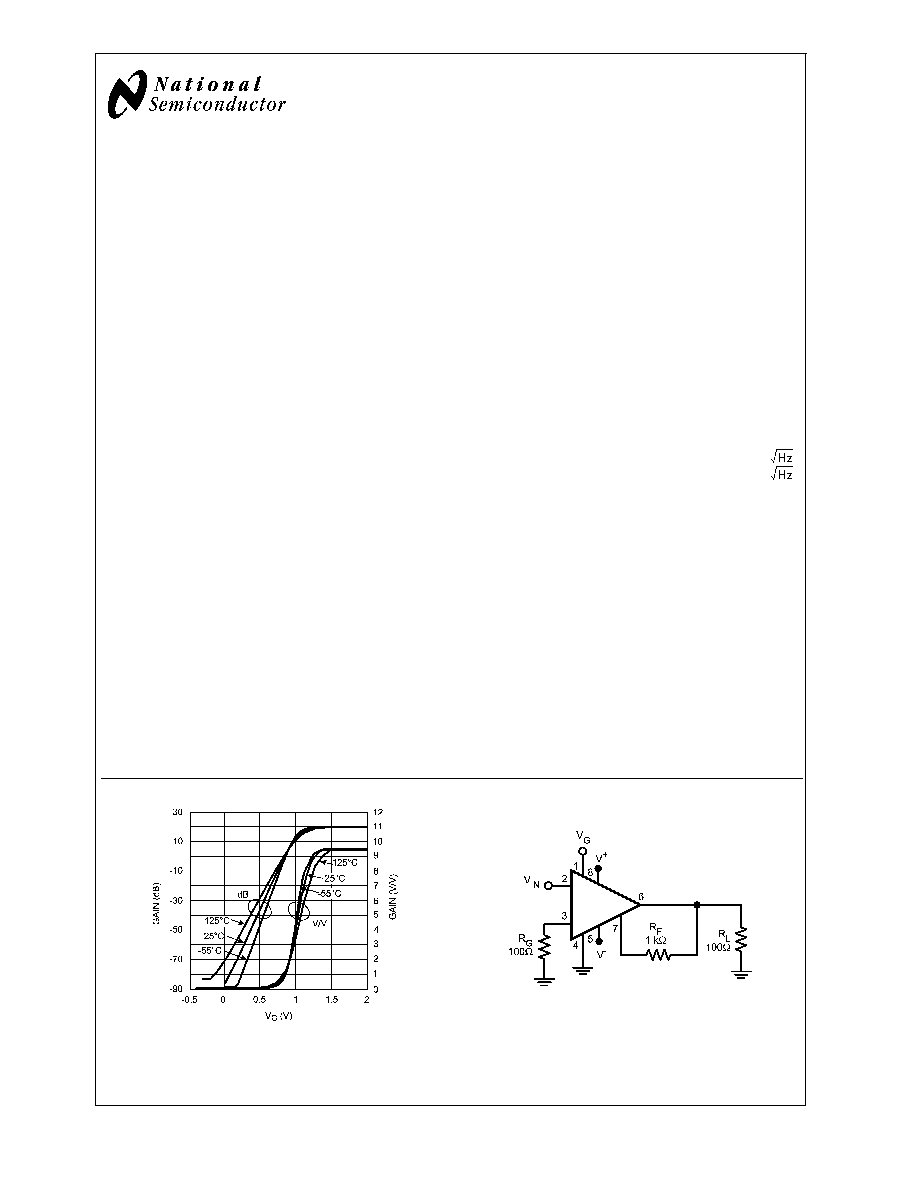
LMH6505
Wideband, Low Power, Linear-in-dB, Variable Gain
Amplifier
General Description
The LMH6505 is a wideband DC coupled voltage controlled
gain stage followed by a high-speed current feedback op
amp which can directly drive a low impedance load. The gain
adjustment range is 80 dB for up to 10 MHz which is accom-
plished by varying the gain control input voltage, V
G
.
Maximum gain is set by external components, and the gain
can be reduced all the way to cut-off. Power consumption is
110 mW with a speed of 150 MHz and a gain control band-
width (BW) of 100 MHz. Output referred DC offset voltage is
less than 55 mV over the entire gain control voltage range.
Device-to-device gain matching is within
±
0.5 dB at maxi-
mum gain. Furthermore, gain is tested and guaranteed over
a wide range. The output current feedback op amp allows
high frequency large signals (Slew Rate = 1500 V/µs) and
can also drive a heavy load current (60 mA) guaranteed.
Near ideal input characteristics (i.e. low input bias current,
low offset, low pin 3 resistance) enable the device to be
easily configured as an inverting amplifier as well.
To provide ease of use when working with a single supply,
the V
G
range is set to be from 0V to +2V relative to the
ground pin potential (pin 4). V
G
input impedance is high in
order to ease drive requirement. In single supply operation,
the ground pin is tied to a "virtual" half supply.
The LMH6505's gain control is linear in dB for a large portion
of the total gain control range from 0 dB down to -85 dB
@
25∞C, as shown below. This makes the device suitable for
AGC applications. For linear gain control applications, see
the LMH6503 datasheet.
The LMH6505 is available in either the SOIC-8 or the
MSOP-8 package. The combination of minimal external
components
and
small
outline
packages
allows
the
LMH6505 to be used in space-constrained applications.
Features
V
S
=
±
5V, T
A
= 25∞C, R
F
= 1 k
, R
G
= 100
, R
L
= 100
, A
V
= A
VMAX
= 9.4 V/V, Typical values unless specified.
n
-3 dB BW
150 MHz
n
Gain control BW
100 MHz
n
Adjustment range (
<
10 MHz)
80 dB
n
Gain matching (limit)
±
0.50 dB
n
Supply voltage range
7V to 12V
n
Slew rate (inverting)
1500 V/µs
n
Supply current (no load)
11 mA
n
Linear output current
±
60 mA
n
Output voltage swing
±
2.4V
n
Input noise voltage
4.4 nV/
n
Input noise current
2.6 pA/
n
THD (20 MHz, R
L
= 100
, V
O
= 2 V
PP
)
-45 dBc
Applications
n
Variable attenuator
n
AGC
n
Voltage controlled filter
n
Video imaging processing
20171011
Gain vs. V
G
Typical Application
20171002
A
VMAX
= 9.4 V/V
January 2006
LMH6505
W
ideband,
Low
Power
,
Linear-in-dB,
V
ariable
Gain
Amplifier
© 2006 National Semiconductor Corporation
DS201710
www.national.com
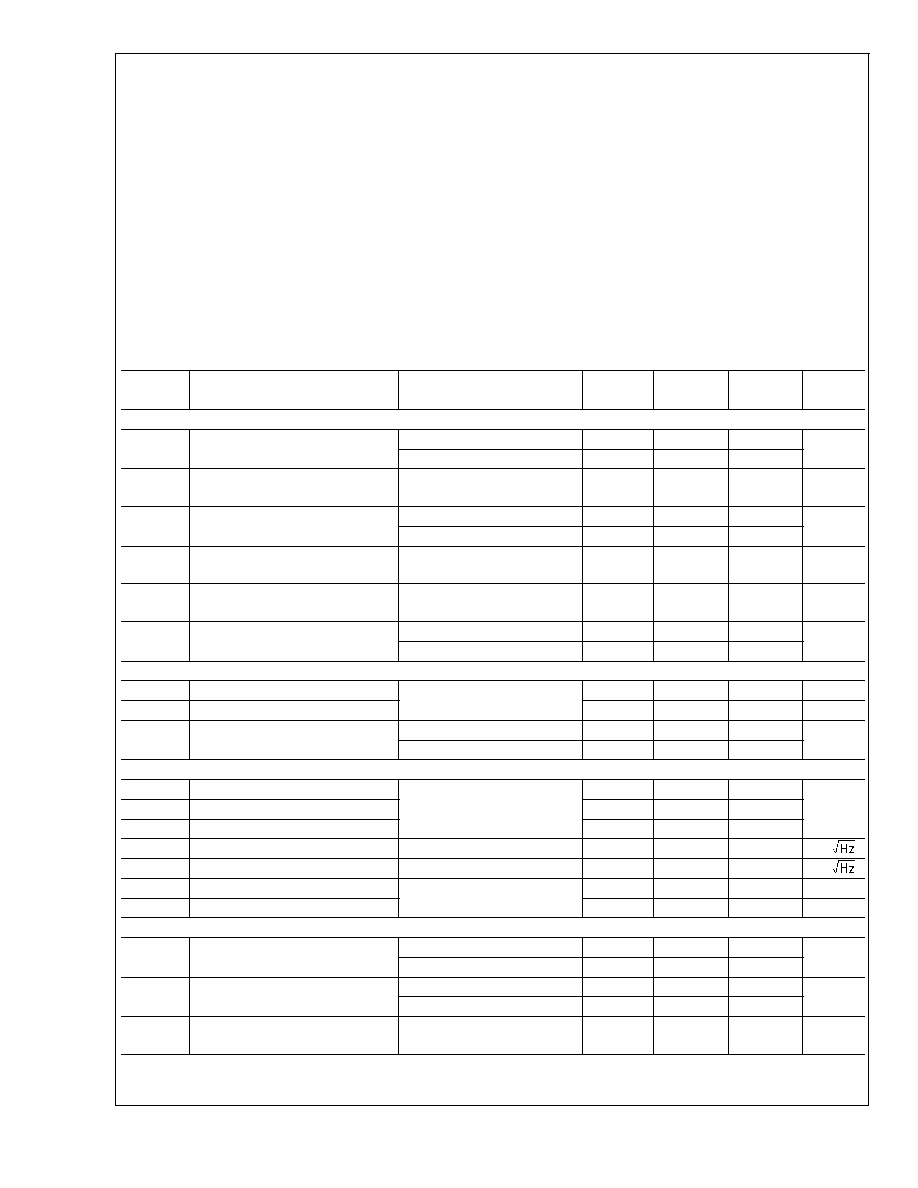
Absolute Maximum Ratings
(Note 1)
If Military/Aerospace specified devices are required,
please contact the National Semiconductor Sales Office/
Distributors for availability and specifications.
ESD Tolerance (Note 4)
Human Body Model
2000V
Machine Model
200V
Input Current
±
10 mA
Output Current
120 mA (Note 3)
Supply Voltages (V
+
- V
-
)
12.6V
Voltage at Input/ Output pins
V
+
+0.8V, V
-
-0.8V
Storage Temperature Range
-65∞C to 150∞C
Junction Temperature
150∞C
Soldering Information:
Infrared or Convection (20 sec)
235∞C
Wave Soldering (10 sec)
260∞C
Operating Ratings
(Note 1)
Supply Voltages (V
+
- V
-
)
7V to 12V
Operating Temperature Range
-40∞C to +85∞C
Thermal Resistance:
(
JC
)
(
JA
)
8 -Pin SOIC
60
165
8-Pin MSOP
65
235
Electrical Characteristics
(Note 2)
Unless otherwise specified, all limits are guaranteed for T
J
= 25∞C, V
S
=
±
5V, A
VMAX
= 9.4 V/V, R
F
= 1 k
, R
G
= 100
, V
IN
=
±
0.1V, R
L
= 100
, V
G
= +2V. Boldface limits apply at the temperature extremes.
Symbol
Parameter
Conditions
Min
(Note 6)
Typ
(Note 6)
Max
(Note 6)
Units
Frequency Domain Response
BW
-3 dB Bandwidth
V
OUT
<
1 V
PP
150
MHz
V
OUT
<
4 V
PP
, A
VMAX
= 100
38
GF
Gain Flatness
V
OUT
<
1 V
PP
0.9V
V
G
2V,
±
0.2 dB
40
MHz
Att Range
Flat Band (Relative to Max Gain)
Attenuation Range (Note 13)
±
0.2 dB Flatness, f
<
30 MHz
26
dB
±
0.1 dB Flatness, f
<
30 MHz
9.5
BW
Control
Gain control Bandwidth
V
G
= 1V (Note 12)
100
MHz
CT (dB)
Feed-through
V
G
= 0V, 30 MHz
(Output/Input)
-51
dB
GR
Gain Adjustment Range
f
<
10 MHz
80
dB
f
<
30 MHz
71
Time Domain Response
t
r
, t
f
Rise and Fall Time
0.5V Step
2.1
ns
OS %
Overshoot
10
%
SR
Slew Rate (Note 5)
Non Inverting
900
V/µs
Inverting
1500
Distortion & Noise Performance
HD2
2
nd
Harmonic Distortion
2V
PP
, 20 MHz
-47
dBc
HD3
3
rd
Harmonic Distortion
≠61
THD
Total Harmonic Distortion
-45
En tot
Total Equivalent Input Noise
f
>
1 MHz, R
SOURCE
= 50
4.4
nV/
I
N
Input Noise Current
f
>
1 MHz
2.6
pA/
DG
Differential Gain
f = 4.43 MHz, R
L
= 100
0.30
%
DP
Differential Phase
0.15
deg
DC & Miscellaneous Performance
GACCU
Gain Accuracy
(See Application Information)
V
G
= 2.0V
0
±
0.50
dB
0.8V
<
V
G
<
2V
+0.1/-0.53
+4.3/-3.9
G Match
Gain Matching
(See Application Information)
V
G
= 2.0V
--
±
0.50
dB
0.8V
<
V
G
<
2V
--
+4.2/-4.0
K
Gain Multiplier
(See Application Information)
0.890
0.830
0.940
0.990
1.04
V/V
LMH6505
www.national.com
2
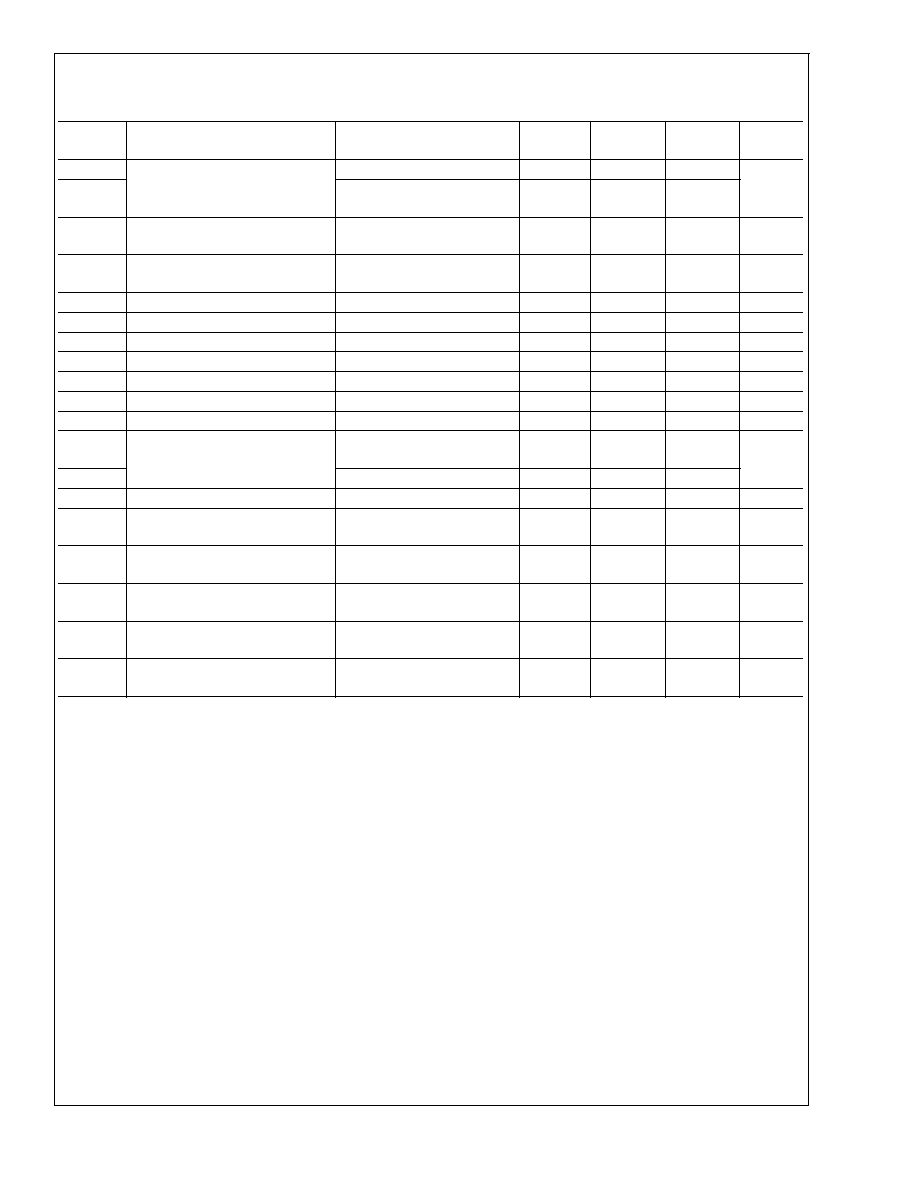
Electrical Characteristics
(Note 2) (Continued)
Unless otherwise specified, all limits are guaranteed for T
J
= 25∞C, V
S
=
±
5V, A
VMAX
= 9.4 V/V, R
F
= 1 k
, R
G
= 100
, V
IN
=
±
0.1V, R
L
= 100
, V
G
= +2V. Boldface limits apply at the temperature extremes.
Symbol
Parameter
Conditions
Min
(Note 6)
Typ
(Note 6)
Max
(Note 6)
Units
V
IN
NL
Input Voltage Range
R
G
Open
±
3
V
V
IN
L
R
G
= 100
±
0.60
±
0.50
±
0.74
I
RG_MAX
R
G
Current
Pin 3
±
6.0
±
5.0
±
7.4
mA
I
BIAS
Bias Current
Pin 2 (Note 7)
-0.6
-2.5
-2.6
µA
TC I
BIAS
Bias Current Drift
Pin 2 (Note 8)
≠190
pA/∞C
R
IN
Input Resistance
Pin 2
7
M
C
IN
Input Capacitance
Pin 2
2.8
pF
I
VG
V
G
Bias Current
Pin 1, V
G
= 2V (Note 7)
0.9
µA
TC I
VG
V
G
Bias Drift
Pin 1 (Note 8)
10
pA/∞C
R
VG
V
G
Input Resistance
Pin 1
25
M
C
VG
V
G
Input Capacitance
Pin 1
2.8
pF
V
OUT
L
Output Voltage Range
R
L
= 100
±
2.1
±
1.9
±
2.4
V
V
OUT
NL
R
L
= Open
±
3.1
R
OUT
Output Impedance
DC
0.12
I
OUT
Output Current
V
OUT
=
±
4V from Rails
±
60
±
40
±
80
mA
V
O
OFFSET
Output Offset Voltage
0V
<
V
G
<
2V
±
10
±
55
±
70
mV
+PSRR
+Power Supply Rejection Ratio
(Note 9)
Input Referred, 1V change,
V
G
= 2.2V
≠65
≠72
dB
-PSRR
-Power Supply Rejection Ratio
(Note 9)
Input Referred, 1V change,
V
G
= 2.2V
≠65
≠75
dB
I
S
Supply Current
No Load
9.5
7.5
11
14
16
mA
LMH6505
www.national.com
3
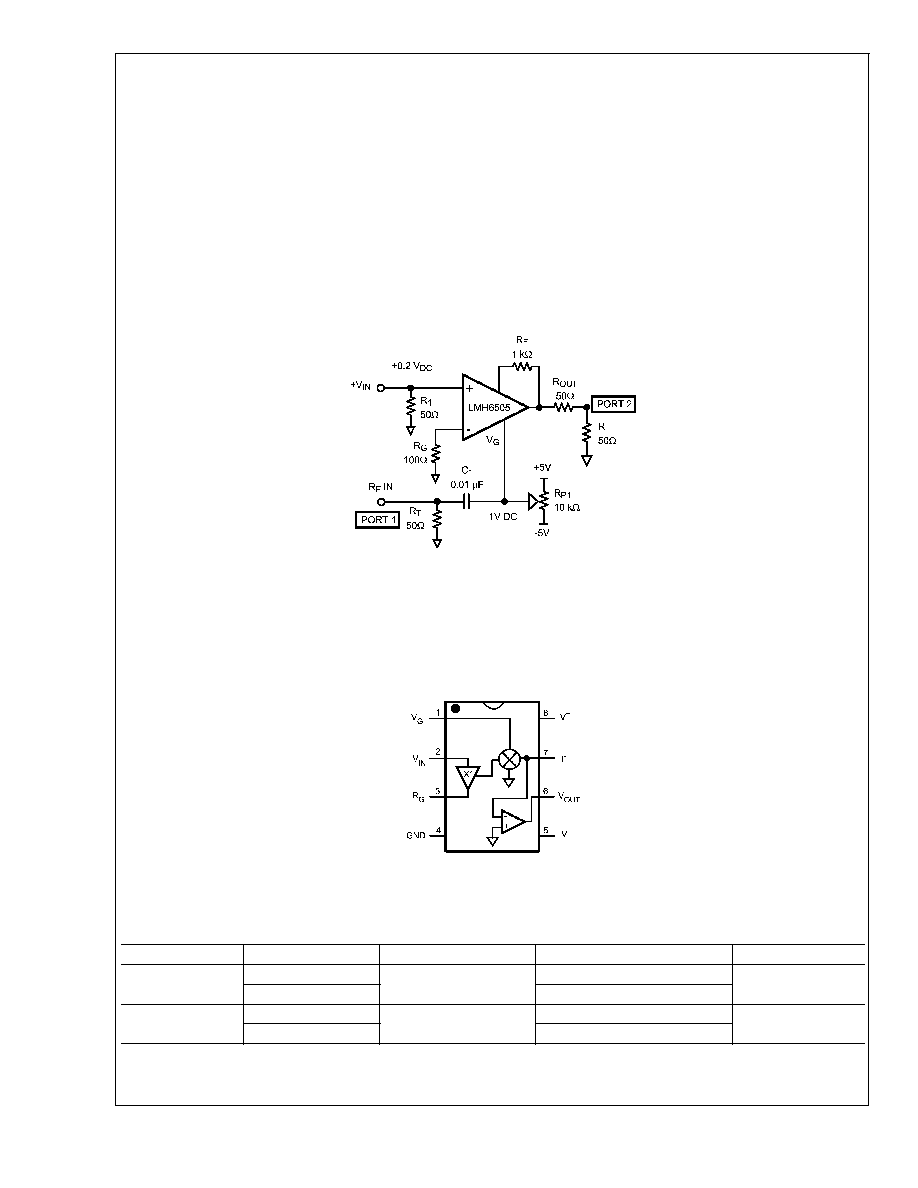
Electrical Characteristics
(Note 2) (Continued)
Note 1: Absolute Maximum Ratings indicate limits beyond which damage to the device may occur. Operating Ratings indicate conditions for which the device is
intended to be functional, but specific performance is not guaranteed. For guaranteed specifications, see the Electrical Characteristics.
Note 2: Electrical Table values apply only for factory testing conditions at the temperature indicated. Factory testing conditions result in very limited self-heating of
the device such that T
J
= T
A
. No guarantee of parametric performance is indicated in the Electrical Tables under conditions of internal self-heating where T
J
>
T
A
.
Note 3: The maximum output current (I
OUT
) is determined by device power dissipation limitations or value specified, whichever is lower.
Note 4: Human Body Model is 1.5 k
in series with 100 pF. Machine Model is 0 in series with 200 pF
Note 5: Slew rate is the average of the rising and falling slew rates.
Note 6: Typical values represent the most likely parametric norm. Bold numbers refer to over temperature limits.
Note 7: Positive current corresponds to current flowing into the device.
Note 8: Drift is determined by dividing the change in parameter distribution at temperature extremes by the total temperature change.
Note 9: +PSRR definition: [|
V
OUT
/
V
+
| / A
V
], -PSRR definition: [|
V
OUT
/
V
-
| / A
V
] with 0.1V input voltage.
V
OUT
is the change in output voltage with offset shift
subtracted out.
Note 10: Gain/Phase normalized to low frequency value at 25∞C.
Note 11: Gain/Phase normalized to low frequency value at each setting.
Note 12: Gain control frequency response schematic:
20171016
Note 13: Flat Band Attenuation (Relative To Max Gain) Range Definition: Specified as the attenuation range from maximum which allows gain flatness specified
(either
±
0.2dB or
±
0.1dB), relative to A
VMAX
gain. For example, for f
<
30 MHz, here are the Flat Band Attenuation ranges:
±
0.2 dB: 19.7 dB down to -6.3 dB = 26 dB range
±
0.1 dB: 19.7 dB down to 10.2 dB = 9.5 dB range
Connection Diagram
8-Pin SOIC
20171001
Top View
Ordering Information
Package
Part Number
Package Marking
Transport Media
NSC Drawing
8-Pin SOIC
LMH6505MA
LMH6505MA
95 Units/Rail
M08A
LMH6505MAX
2.5k Units Tape and Reel
8-Pin MSOP
LMH6505MM
A93A
1k Units Tape and Reel
MUA08A
LMH6505MMX
3.5k Units Tape and Reel
LMH6505
www.national.com
4
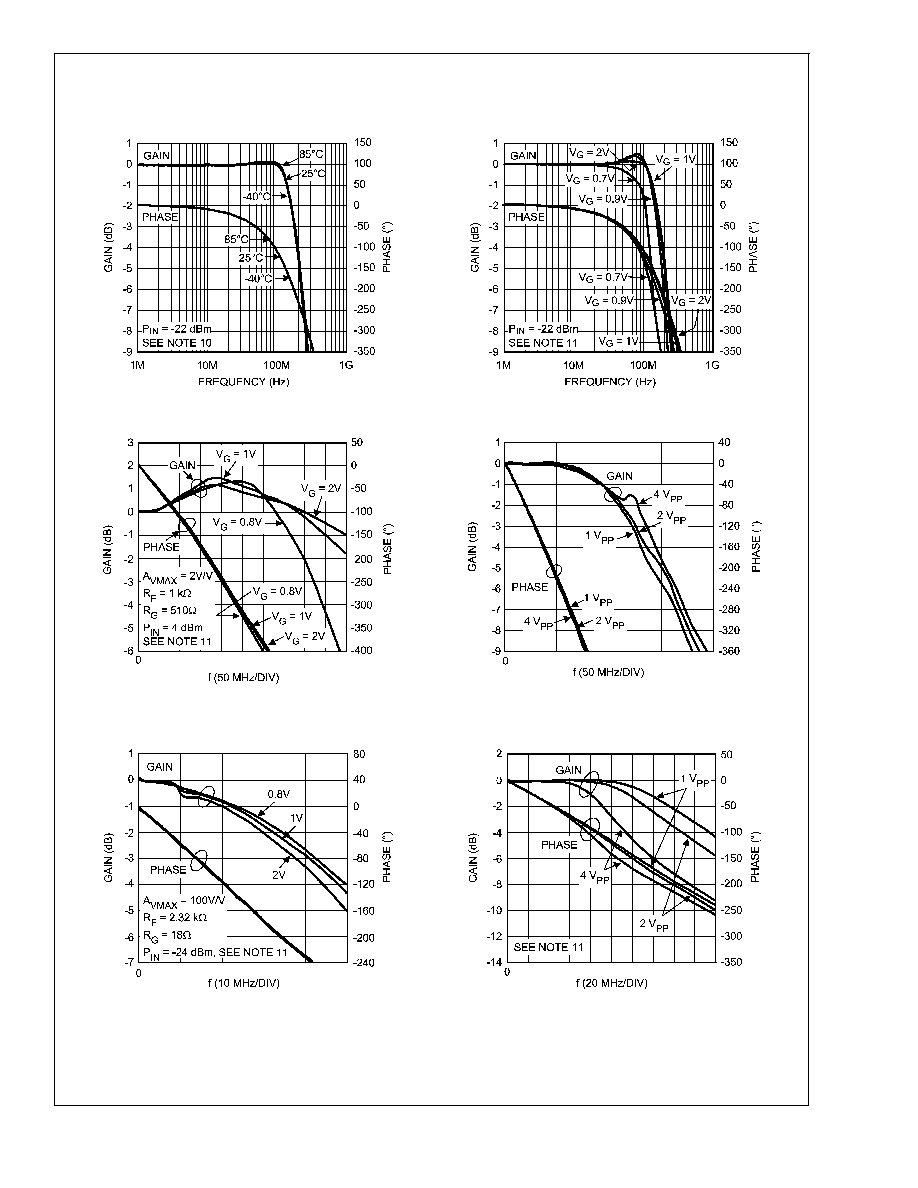
Typical Performance Characteristics
Unless otherwise specified: V
S
=
±
5V, T
A
= 25∞C,
V
G
= V
GMAX
, R
F
= 1 k
, R
G
= 100
, V
IN
= 0.1V, input terminated in 50
. R
L
= 100
, Typical values.
Frequency Response Over Temperature
Frequency Response for Various V
G
20171003
20171004
Frequency Response (A
VMAX
= 2)
Inverting Frequency Response
20171046
20171044
Frequency Response for Various V
G
(A
VMAX
= 100)
(Large Signal)
Frequency Response for Various Amplitudes
20171045
20171064
LMH6505
www.national.com
5




